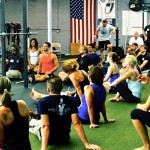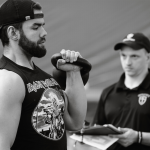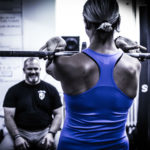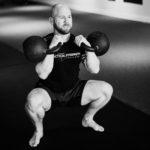There is no denying the benefits of the hard style kettlebell jerk. Whether your goal is power, strength, hypertrophy, or endurance, these can all be accomplished by training the hard style jerk.
There are various drills and exercises to improve the hard style clean and jerk, but for today and for the sake of simplicity, I will only be discussing how the front squat can improve your clean and jerk.
The Kettlebell Rack Position
Once the bells are cleaned into the rack position, a few things need to happen:
- The body stays zipped up. Basically it is performing a plank, but in the standing position.
- The elbows are connected to the rib cage and the kettlebells become part of your body. The elbows should be pointed toward the ground. If the elbows point toward anywhere else, you are most likely disconnected and will experience a power leakage later in the lift.
The Barbell Rack Position
The same principles apply to the barbell rack position:
- The bar should rest slightly behind the collarbone, on the front delts and slightly touching but not choking your neck.
- The elbows should be at least be perpendicular to the floor. This is where the body can handle the heaviest load, and this angle allows you to stay connected to the bar.
In both instances, the implement becomes one with the body. A good rack position, either with the kettlebell or the barbell, is the foundation to technical proficiency.
The First Dip
The groove of the first dip in the hard style kettlebell jerk is vital to successfully completing the lift. We know the first dip is getting sloppy when one or more of the following things go wrong:
- The heels come off the ground.
- The elbows shoot off the ribs and disconnect from the torso.
- The shin angles excessively forward when dipping.
If any of these happen, you are robbing yourself of power. In the photo below, you can see glaring differences in rack positions. The photo on the left has major technical flaws while the photo on the right is technically sound.

If your first dip looks like the photo on the left, the barbell front squat might be exactly what you need.
Why Does the Front Squat Help the Clean and Jerk?
The groove of the first dip in the kettlebell jerk and the barbell front squat should be almost identical. This is exactly why a solid month of front squats will do wonders for your jerk.
If you go heavy enough, you cannot cheat the front squat. There is no way the heels will come up, the shin angle needs to be spot on, and the bar needs to rest perfectly on the shoulder girdle. These are the reasons why the front squat is your key to a better kettlebell clean and jerk.
Kettlebell First Dip Versus Barbell Front Squat
In the photos below, you can see that the shin angle, hip and and torso angle are very similar between the movement done with kettlebell and with the barbell. There are a few small differences, but overall they demonstrate the same proper mechanics for optimal torque and power production. Once you start programming front squats into your routine, I can pretty much guarantee the bells will start moving with greater ease in your jerk.

Programming
I would recommend the Easy Strength approach when adding the front squat into your current program. Train the front squat every session, keeping the reps at ten total per day. Gradually increase the weight. Go heavier when you feel good and never miss a rep.









Thanks for a great article.
Thank you for this great post, we are currently working on the Clean & Jerk.
It is a difficult thing for the Olympic lifter since the demise of the press to NOT have great legs. Well, I was/am one of them. As a junior in college, I lifted in a meet and needed 165/363 pounds to win. Well, I cleaned it, bounced up and jerked it for three white lights. Now the interesting thing is that my lifetime best front squat was 365. Dick Notmeyer had a mantra: “If you can front squat it for three, you can clean and jerk it.” Later, at the Utah Summer Games, in 1991, I cleaned 182.5/402 stood up and lost the jerk behind. Again, my best front squat was 405.
Thx Rif 🙂
great post and very important tip.